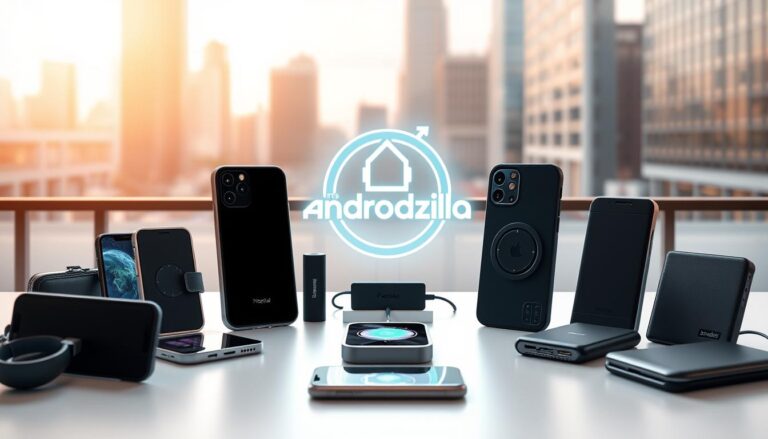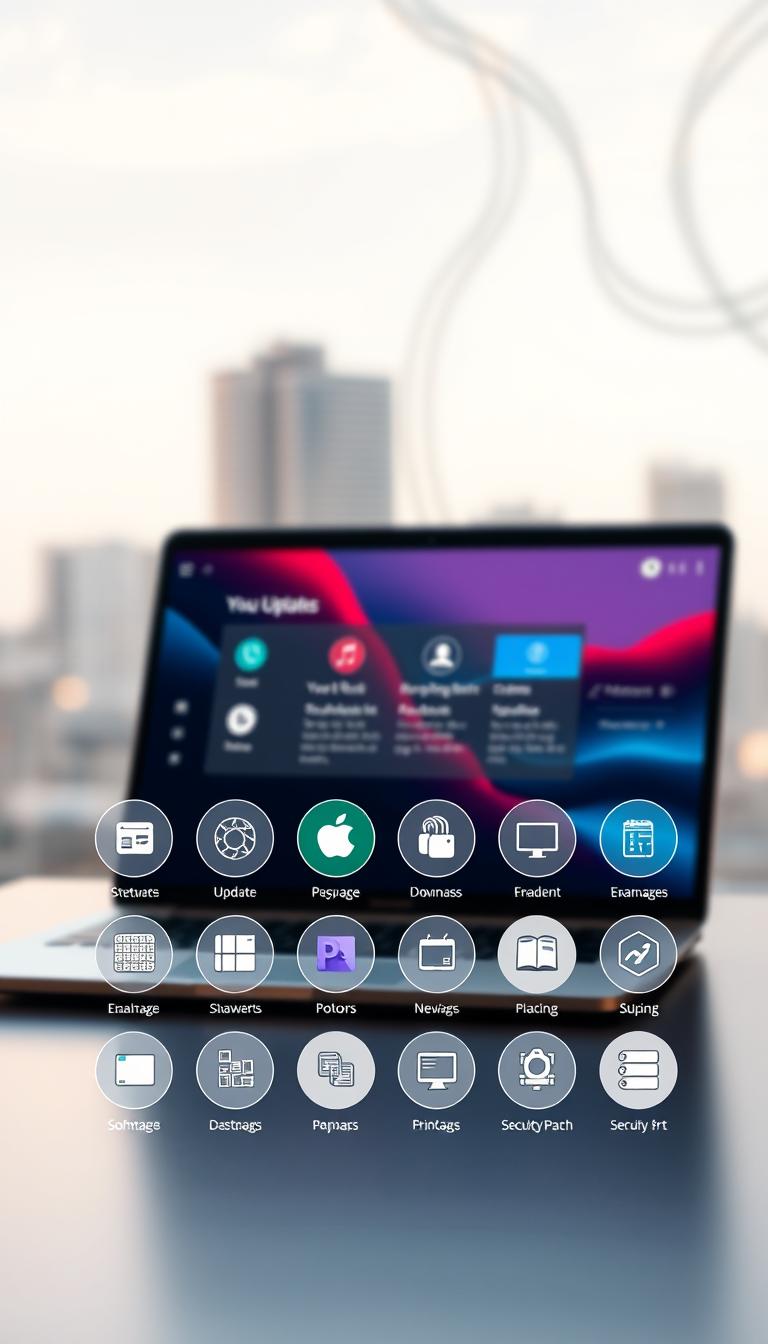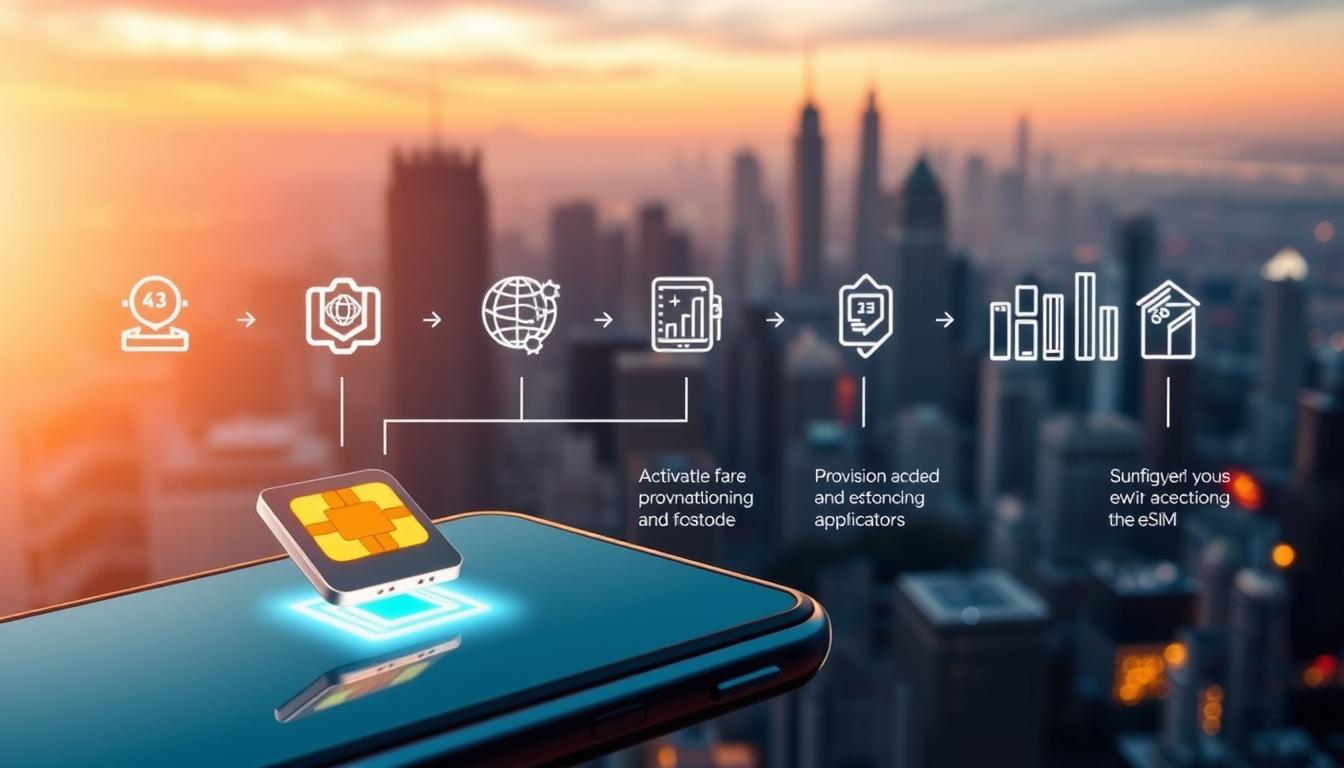
Imagine a world where switching carriers or managing multiple devices no longer requires physical SIM cards. That’s the reality eSIM technology brings to the table. It’s not just a convenience—it’s a game-changer for businesses and individuals alike.
With eSIMs, we can eliminate the hassle of physical SIM cards, reduce operational costs, and ensure seamless connectivity across devices. This technology allows devices to automatically connect to the strongest available network, improving reliability in areas with weak signals1.
For businesses, this means faster scaling, better logistics, and enhanced operational efficiency. Whether you’re in healthcare, logistics, or transportation, eSIMs can revolutionize how you manage devices and data1.
In this guide, we’ll walk you through the essential steps to implement this technology successfully. From understanding its benefits to mastering the technical details, we’ve got you covered.
Key Takeaways
- eSIM technology eliminates the need for physical SIM cards, saving time and money.
- Devices can automatically connect to the strongest network, ensuring reliable connectivity.
- Businesses can scale operations quickly with remote provisioning and activation.
- Monitoring tools provide real-time updates on device status and data usage.
- Strong security measures are essential to protect eSIM devices and data.
Understanding the eSIM Landscape
The rise of eSIM technology is reshaping how devices connect globally. This innovation eliminates the need for physical SIM cards, offering a more streamlined and efficient solution for organizations. With remote provisioning, devices can be activated and managed seamlessly, reducing logistical challenges2.
Exploring eSIM Capabilities and Benefits
eSIMs enable devices to store multiple profiles, allowing users to switch carriers effortlessly. This flexibility is particularly useful for frequent travelers or businesses managing IoT devices. For example, a global trucking company can provision telematics devices post-installation, optimizing operations across continents2.
Another key benefit is enhanced security. Built-in encryption mechanisms reduce the risk of data interception, making eSIMs a reliable choice for sensitive applications3. Additionally, this technology supports remote firmware updates, ensuring devices remain up-to-date with evolving network requirements2.
Industry Trends and Future-Proofing Devices
The IoT market is rapidly adopting eSIMs for their ability to provide secure, reliable connectivity. Advanced profiles and simulation management tools ensure devices can adapt to changing network conditions2. This future-proofing is critical as cellular networks evolve and new technologies emerge.
Industry leaders are also leveraging carrier-agnostic solutions to support multiple network types. This approach ensures devices remain connected, regardless of local carrier availability2. As the global eSIM market grows, these trends will continue to shape the connectivity landscape3.
Defining Your eSIM Strategy
Crafting a clear plan is the foundation of any successful technology integration. To maximize the benefits of this innovation, we must first assess both business and technical needs. This ensures the chosen approach aligns with organizational goals and operational dynamics4.
Assessing Your Business and Technical Needs
Start by evaluating your organization’s specific requirements. Consider factors like scale, device types, and connectivity demands. For example, a logistics company may need robust solutions for tracking fleets across borders5.
Technical needs include compatibility with existing systems and the ability to handle multiple profiles. This flexibility is crucial for businesses managing diverse devices or global operations4.
Setting Deployment Goals and Milestones
Define clear, measurable goals to guide your strategy. These could include reducing costs, improving connectivity, or streamlining activation processes5. Setting milestones helps track progress and ensures alignment with long-term objectives.
For instance, a pilot program can test the solution’s effectiveness before full-scale implementation. This approach minimizes risks and provides valuable insights4.
| Factor | Consideration |
|---|---|
| Scale | Number of devices and geographic coverage |
| Profiles | Ability to store and switch multiple carrier profiles |
| Integration | Compatibility with existing systems |
| Security | Built-in encryption and compliance standards |
Aligning technical needs with business objectives ensures a seamless transition and maximizes return on investment. By carefully assessing and setting goals, organizations can unlock the full potential of this transformative technology5.
Mastering the esim deployment process
To unlock the full potential of modern connectivity, mastering the eSIM implementation is essential. This technology offers a streamlined approach to managing devices, ensuring flexibility and efficiency. By following a structured roadmap, organizations can achieve seamless integration and maximize operational benefits6.
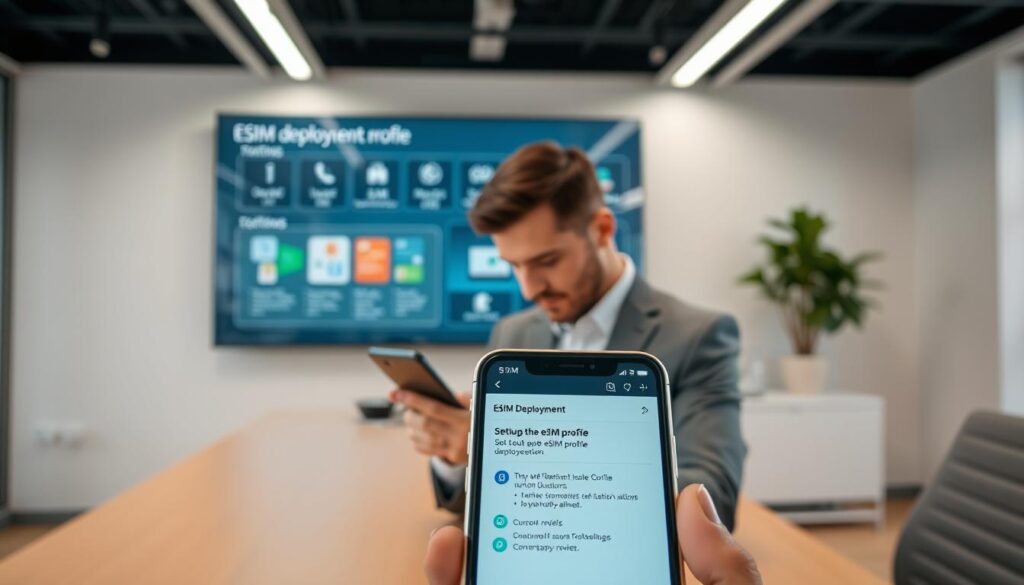
Step-by-Step Implementation Roadmap
Successful integration begins with a clear plan. Start by assessing your organization’s needs, including device types and connectivity requirements. This ensures compatibility with existing systems and future scalability6.
Next, focus on secure authentication measures. Implementing GSMA-aligned applets ensures devices are protected from unauthorized access. Remote provisioning simplifies activation, reducing the need for physical interventions7.
Testing is a critical phase. Pilot programs allow you to evaluate the solution’s effectiveness before full-scale rollout. This minimizes risks and provides valuable insights for optimization6.
Leveraging Carrier-Agnostic Solutions for Flexibility
One of the key advantages of this technology is its ability to support multiple carriers. This flexibility is particularly useful for businesses operating across borders or managing diverse devices7.
By using carrier-agnostic solutions, organizations can switch networks seamlessly. This ensures uninterrupted connectivity, even in areas with weak coverage. It also reduces dependency on a single provider, enhancing reliability8.
Effective mobile device management plays a crucial role in large-scale implementations. Centralized platforms simplify monitoring and updates, ensuring devices remain operational and secure6.
“Flexibility and security are the cornerstones of successful eSIM integration.”
Methodical planning and testing are essential for a smooth rollout. By following these steps, organizations can unlock the full potential of this transformative technology7.
Evaluating eSIM Solutions and Options
Choosing the right connectivity solution can make or break your device’s performance. Whether you’re managing IoT devices or personal gadgets, understanding the differences between embedded and removable eSIMs is crucial. Each option has its advantages and challenges, and selecting the right one depends on your specific needs.

⭐️ Tap the exclusive deal link https://temu.to/k/uot8tcxvwum to score top-quality items at ultra-low prices. 🛍️ These unbeatable deals are only available here. Shop now and save big! ⭐️ Directly get exclusive deal in Temu app here: https://app.temu.com/m/mhb5rstagbx
Another surprise for you! Click https://temu.to/k/uag0bn0o0wd to earn with me together🤝!
Comparing Embedded and Removable eSIMs
Embedded eSIMs, also known as MFF2 form factors, are permanently integrated into devices. This design enhances durability, making them ideal for applications in harsh environments like healthcare or industrial IoT9. On the other hand, removable eSIMs offer flexibility, allowing users to switch devices without replacing the SIM card.
Embedded eSIMs simplify global manufacturing by eliminating the need for manual SIM insertion. This reduces costs and streamlines production9. However, removable eSIMs can be beneficial for devices that require frequent upgrades or replacements.
Ensuring Security, Interoperability, and Longevity
Security is a top priority when evaluating eSIM solutions. Embedded eSIMs often come with built-in encryption and robust profile management, ensuring long-term device performance10. These features are essential for applications like connected vehicles or healthcare devices, where data integrity is critical.
Interoperability is another key factor. eUICC technology allows devices to store multiple profiles, enabling seamless switching between networks9. This flexibility is particularly useful for devices operating in diverse geographic locations.
Finally, longevity is a critical consideration. Devices expected to operate for 10-15 years require durable and future-proof solutions. Embedded eSIMs, with their sealed design and remote provisioning capabilities, are well-suited for such applications9.
- Embedded eSIMs enhance durability and reduce manufacturing costs.
- Removable eSIMs offer flexibility for device upgrades.
- Security protocols ensure data integrity and long-term performance.
- Interoperability allows seamless network switching.
By carefully evaluating these factors, organizations can choose the right eSIM solution to strengthen their technology ecosystem.
Deploying Your eSIM Solution Successfully
Achieving success with modern connectivity solutions requires a strategic approach that goes beyond technology. It involves strict regulatory compliance, well-planned pilot programs, and a refined focus on supply chain and logistics. These elements ensure rapid scalability and operational efficiency11.
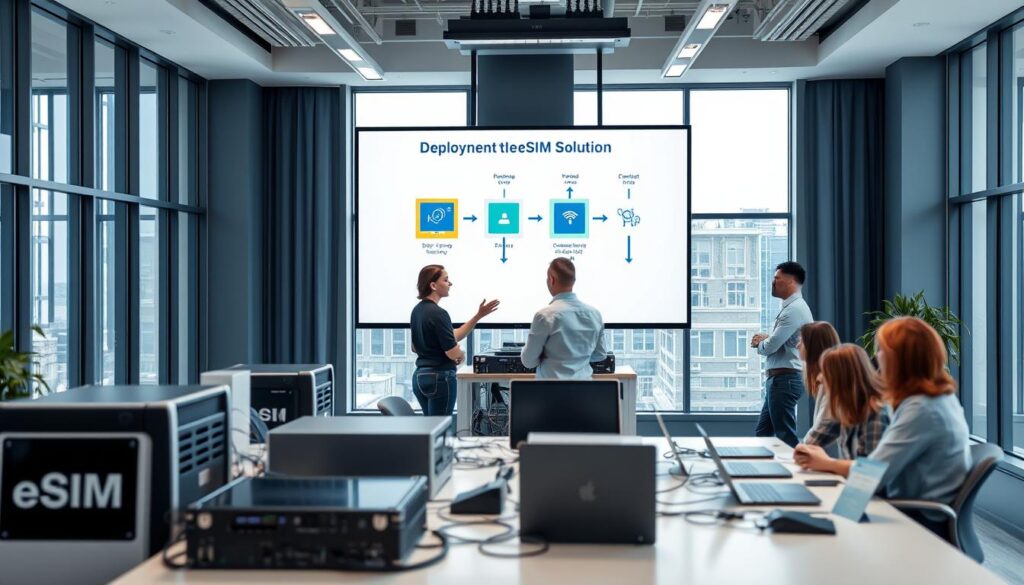
Regulatory Compliance and Pilot Program Strategies
Regulatory compliance is a cornerstone of any successful rollout. Organizations must adhere to global standards to maintain consumer confidence and reduce legal risks12. This includes implementing cutting-edge encryption algorithms and multifactor authentication to protect sensitive data.
Pilot programs serve as a proving ground to gather feedback and fine-tune the solution. Testing techniques, such as acquiring a test kit with multiple eSIMs, are essential for validating the provisioning process before full-scale implementation12. This approach minimizes risks and ensures a smoother transition.
Optimizing Supply Chain and Logistics Management
Efficient supply chain and logistics management are critical for a successful rollout. Cloud-based software and centralized platforms help streamline operations, reducing downtime and improving overall efficiency11. This ensures that devices are provisioned and activated seamlessly, regardless of geographic location.
Proactive customer support and robust post-deployment monitoring are equally important. These measures ensure sustainable service performance and address any issues promptly. Meticulous scheduling and cost management also play a vital role in maintaining operational efficiency12.
| Key Factor | Best Practice |
|---|---|
| Regulatory Compliance | Adhere to global standards and implement robust security measures |
| Pilot Programs | Use test kits and gather feedback to refine the solution |
| Supply Chain Management | Leverage cloud-based software for streamlined operations |
| Customer Support | Provide proactive monitoring and timely issue resolution |
By focusing on these strategies, organizations can unlock the full potential of their connectivity solutions. This approach not only enhances operational efficiency but also ensures long-term success in a rapidly evolving market11.
Managing and Optimizing Your eSIM Connectivity
Efficiently managing connectivity across multiple devices is now simpler than ever with centralized platforms. These tools provide a unified approach to ensure seamless performance and flexibility for users. By leveraging advanced solutions, organizations can enhance their operational efficiency and reduce complexity13.

Centralized Connectivity Management Platforms
Centralized platforms are essential for maintaining optimal performance across devices. They offer a single point of access for managing multiple profiles, simplifying operations for businesses and end-users alike. This approach ensures that updates and troubleshooting can be handled efficiently14.
These platforms also provide enhanced flexibility, allowing users to switch between networks effortlessly. For example, a logistics company can manage its fleet’s connectivity across different regions without manual intervention. This reduces downtime and improves overall productivity15.
Real-Time Monitoring, Diagnostics, and Performance Enhancements
Real-time monitoring is a game-changer for device management. It offers transparency into network and device performance, enabling proactive issue resolution. Automated alerts ensure that potential problems are addressed before they impact operations13.
Diagnostics tools provide detailed insights into usage patterns, helping organizations optimize data plans and reduce costs. For instance, monitoring data consumption can identify inefficiencies and drive incremental improvements14.
- Centralized platforms simplify management and reduce operational complexity.
- Real-time monitoring ensures proactive issue resolution and optimal performance.
- Diagnostics tools provide insights for cost optimization and efficiency improvements.
By integrating these strategies, organizations can achieve sustained optimization and seamless connectivity. This approach not only enhances user experience but also ensures long-term success in a rapidly evolving market15.
Conclusion
Adopting advanced connectivity solutions can transform how businesses operate globally. By selecting the right provider and leveraging centralized platforms, organizations can streamline operations and enhance efficiency. This approach ensures seamless integration across devices and locations, reducing costs and improving scalability16.
Regulatory compliance and robust support systems are essential for sustaining service quality. Remote provisioning and secure authentication protocols, aligned with GSMA standards, safeguard data and ensure long-term performance17. These measures not only protect sensitive information but also build trust with end-users.
Centralized management tools offer the flexibility to monitor and optimize connectivity in real-time. This capability is crucial for industries like healthcare and logistics, where uninterrupted access to data drives success18. By focusing on continuous improvement, businesses can future-proof their operations and stay ahead in a competitive market.
We invite you to explore further resources and case studies to deepen your understanding of this innovative ecosystem. Our commitment is to guide you through every step, ensuring your journey is backed by proven best practices and industry expertise.
FAQ
What is an eSIM and how does it work?
What are the benefits of using eSIM technology?
How do I deploy eSIMs in my organization?
Can eSIMs be used across different devices and networks?
How secure are eSIMs compared to traditional SIM cards?
What industries benefit most from eSIM deployment?
How do I manage eSIM profiles after deployment?
What challenges might I face during eSIM deployment?
Can eSIMs be used in IoT devices?
How does eSIM technology future-proof my devices?
Source Links
- https://www.globalyo.com/step-by-step-guide-esim-m2m-instructions-for-seamless-connectivity/ – Step-by-Step Guide: eSIM M2M Instructions [2024] | Global YO
- https://www.hologram.io/blog/esim-iot-deployment-landscape/ – What does an Enterprise IoT deployment look like with eSIM?
- https://www.globalyo.com/understanding-how-esim-works/ – Understanding How eSIM Works [2024] | Global YO
- https://kigen.com/wp-content/uploads/2024/10/eSIM-guide_finalweb_AF.pdf – PDF
- https://www.gsma.com/solutions-and-impact/industry-services/wp-content/uploads/2023/10/GSMA_eSIM-Starter-Guide_Top-Tips.pdf – PDF
- https://www.idemia.com/insights/mastering-esim-iot-scale-key-insights-sgp3132-early-implementations – Mastering eSIM IoT implementation at scale | IDEMIA
- https://www.globalyo.com/mastering-embedded-esim-a-comprehensive-tutorial-guide/ – Mastering Embedded eSIM [2024]: Comprehensive Tutorial Guide | Global YO
- https://www.globalyo.com/mastering-esim-iot-step-by-step-tutorials-for-seamless-connectivity/ – Mastering eSIM on Android [2024]: Comprehensive Guide | Global YO
- https://www.hologram.io/blog/what-is-an-esim-and-how-is-it-used/ – What is an eSIM and how is it changing industries?
- https://www.globalyo.com/mastering-esim-cellular-troubleshooting-a-comprehensive-guide/ – Mastering eSIM Cellular Troubleshooting [2024]: Comprehensive Guide | Global YO
- https://www.korewireless.com/news/esim-deployment-key-stages-steps-launch-embedded-smart-sim – 4 Key Stages of Your eSIM Deployment
- https://spenza.com/blog/steps-for-mvnos-to-implement-esim-technology/ – Steps for MVNOs to Implement eSIM Technology – Spenza
- https://www.thalesgroup.com/en/markets/digital-identity-and-security/mobile/connectivity/esim – How eSIM solutions can help you with your connectivity needs
- https://telnyx.com/resources/corporate-esim-management – Simplifying corporate mobile plans with eSIM management
- https://www.globalyo.com/streamlining-connectivity-effective-strategies-for-managing-esim-profiles/ – Managing eSIM Profiles [2024]: Effective Strategies | Global YO
- https://www.globalyo.com/revolutionizing-connectivity-the-future-of-remote-esim-deployment/ – Remote eSIM Deployment [2024]: Future of Connectivity | Global YO
- https://www.gsma.com/esim/wp-content/uploads/2018/12/esim-whitepaper.pdf – PDF
- https://www.thalesgroup.com/en/markets/digital-identity-and-security/mobile/connectivity/esim/instant-connect – Thales Instant Connect: eSIM provisioning connectivity service for the IoT


